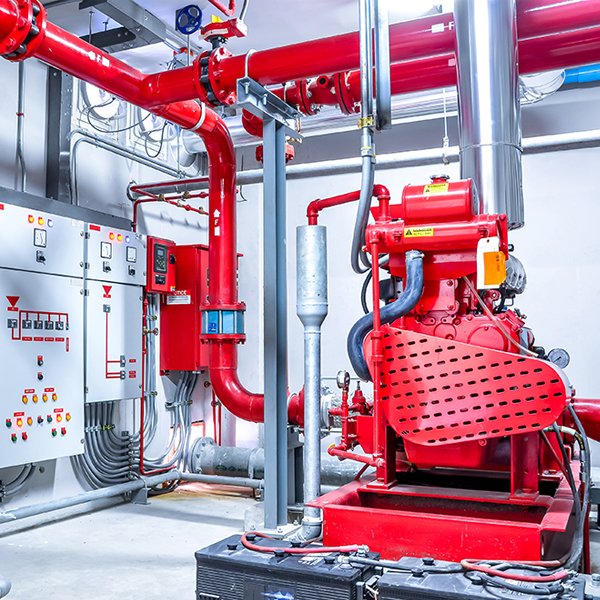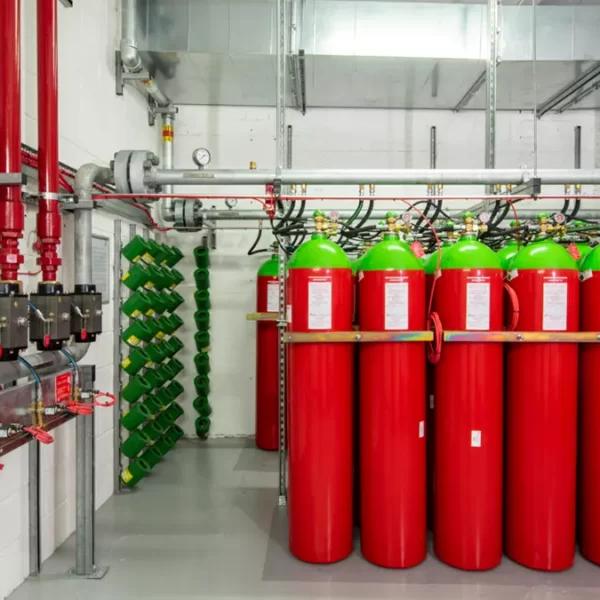6 Main Types of Fire Suppression Systems and Their Uses


6 Main Types of Fire Suppression Systems and Their Uses
Everyone knows that fire extinguishers play a very important role in their workplace needs. And everyone should know where the nearest one is. However, many do not realize that a single fire extinguisher does not work on all types of fires. There are different types, or classes, of fire extinguishers, just as there are different classes of fires.
To provide true safety at your workplace, you need to know you have the right extinguisher for the potential fire hazards in your building.
Fire suppression systems are essential in fire safety because they help early detection, and speed up reactions to life-threatening incidents. It maximizes the safety of people and property because of Using different types of fire suppressants, like clean agents or carbon dioxide, fire suppression systems beat the fire and stop it from spreading.
In this article, we’ll discuss what is suppression systems, how they work, and their uses and know how this system keeps buildings and occupants safe in case of emergency.
What Is Fire Suppression?
Fire suppression acts as controlling and extinguishing a fire once it has started. It includes all efforts from discovering the fire to completely putting it out. Fire suppression helps keep the fire controlled, preventing it from spreading to other areas. It reduces damage and plays an important role in fire safety.
What Is a Fire Suppression System?
A fire suppression system is made to stop a fire and prevent it from spreading. These systems are activated by heat, smoke, or both, and always contain fire detection and alert technology. They work automatically, without manual input, and use agents like 3M™ Novec™ 1230 or CO2 to quickly put out fires. Fire suppression systems help control and extinguish fires and enhance safety.
How do fire suppression systems work?
Fire suppression systems use dry chemicals or wet agents to quickly neutralize fires before they get out of control. Fires need fuel, oxygen, heat, and a combustion chain reaction to ignite and keep burning. This is shown in the ‘fire tetrahedron’. To extinguish a fire, one of these elements must be eliminated or their balance changed. Fire suppression systems work by:
- Disrupting the combustion chain reaction
- Containing or removing the fuel source
- Diluting or cutting off the oxygen source
- Removing sufficient heat from the fire
6 Main Types of Fire Suppression Systems
The different types of fire suppression systems are here and how you can determine which one is best for your requirement.
#1. Water Sprinkler Suppression Systems
Water sprinkler suppression systems are a tested form of fire protection used for decades to protect facilities from fire damage. This type of fire sprinkler system uses water-based, pressurized nozzles that are activated by heat sensors and start when the temperature reaches a specific set point.
Water-based fire suppression is an effective solution for businesses or homes to help manage, cool, and extinguish a fire quickly and efficiently before it spreads. They are also very reliable, cost-effective, easy to maintain, and use. Additionally, water sprinklers work without electricity or any other power source providing effective fire safety even during power outages.
#2. Pneumatic Heat Detection Systems
Pneumatic heat detection systems concern air pressure-based detectors that are activated by changes in temperature. This system is the best for Small machinery, electrical switch cabinets, and fume cupboards.
Manual intervention is not needed with pneumatic heat detection systems, once the sensors notice a temperature change, they are immediately started and a gas suppression system can be started to help control and extinguish the flames. In some cases, these systems can be connected to an alarm system that will warn to occupants of any possible risk.
#3. Chemical Foam Suppression Systems
Chemical foam suppression system helps to prevent or control fires in buildings where flammable liquids are kept or used regularly. This system uses special foam mixed with water, carbon dioxide, and other chemicals to make a covering of foam that extinguishes the fire quickly.
When activated by smoke detectors, heat sensors, or manual activation, it release large amounts of highly effective foam which works as an insulator to ensure complete extinguishing of the flames.
#4. Pressurized Gas Systems
Pressurized gas systems are an effective and efficient system to protect buildings from fires because use inert gases, like nitrogen or carbon dioxide, to replace oxygen while cooling the fuel source of a fire.
This controls flames from spreading and saves equipment like computers or documents after the fire is out. Automated and remote-controlled pressurized gas systems are easy to install and need low maintenance, making them a cost-effective fire suppression choice.
#5. Foam Deluge Systems
Foam deluge systems have become popular for large-scale fire control, particularly in areas with combustible fuels and flammable materials. These systems help to put out fires before they cause harm or damage because they can quickly choke the fuel source and stop the flames.
Also, it provides the highest level of safety, foam deluge systems are less expensive to set up and up than alternative fire suppression technologies like pressurized gas or sprinkler systems. Foam deluge systems have become the standard for avoiding fires in many businesses and manufacturing facilities because of their effectiveness and affordability.
#6. Water Mist Systems
Water mist systems are a reliable and effective fire suppression option popular for use in large-scale applications such as industrial facilities and commercial buildings. The method by which the system operates is by producing small water droplets that can quickly reduce a fire’s temperature while causing the least amount of damage to nearby property or the environment.
Why are fire suppression systems important?
Fire suppression systems are very important to increase the level of fire safety within a business site and also work as an effective way of reducing the danger of serious damage being generated by fire.
Also, fire suppression systems can provide you and your employee peace of mind and true safety when on site, to understanding that if a fire breaks out, the suppression system would automatically start and the fire would be controlled or extinguished.
Uses of Fire Suppression System:
For regulations for commercial buildings, a fire suppression system is essential for keeping your building and its occupants safe and helps stop fires to minimize damage spread. Other benefits include:
- Save lives
Most use of fire suppression systems are to save lives and due to working automatically, do not put the responsibility on a person to start the system.
- Reduce property damage and loss
Once installed, a fire suppression system will immediately enhance the overall site as well as employee and visitor safety with reduced property damage and loss, due to having the ability to reduce the spread and/or extinguish a fire.
- Stay code-compliant with regulations:
Fire suppression systems ensure your building meets all safety codes and regulations.
- Provide 24-hour protection:
These systems offer round-the-clock fire protection, even when no one is around.
- Reach emergency services immediately:
They can automatically alert emergency services, speeding up response times.
- Return to normal operations quicker:
By quickly having fires, these systems allow your business to resume normal operations quickly.
- Early fire detection
These systems can detect the very early signs of fire breaking out and therefore can start a quick response, thus reducing the amount of damage carried out.
- Fast & effective
Fire suppression systems work automatically, meaning they are fast and useful in maintaining a fire and reducing or breaking one of the fire tetrahedron sources or links.
- Suitable for most sites
Another benefit is that these systems can be installed in almost all site situations and are appropriate for the majority of industries and businesses.
- Fire safety compliant
Fire suppression systems are all tested in a laboratory setting and have been scientifically proven to extinguish a fire, as well as being compliant with all industry legislation.
Conclusion
A fire suppression system is essential to keep your building and its occupants safe. Any safety plan must involve fire suppression systems, which need to be regularly checked and maintained so that they will work as planned when needed. In selecting the best system for your business, you should take into account the building’s height, materials, and helpfulness as well as any applicable codes or regulations. Businesses can ensure the safety and protection of their facilities by considering these important parts.
https://www.youtube.com/embed/cveuVXqrYq4https://www.youtube.com/embed/vouWAx-VWhghttps://www.youtube.com/embed/aMi7iXD0l9I



